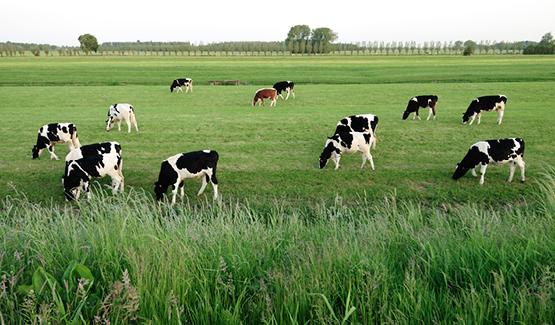Fresh, clean air is a basic necessity for human, plant, and animal health, and a valued feature of life in the EU.
The common agricultural policy supports farmers who protect air quality as part of a sustainable agricultural system.

Clean air and agriculture in the EU
Along with soil and water, clean air is an essential natural resource for agriculture. However, agriculture is a significant source of air pollution:
- agriculture accounts for around 93% of total ammonia emissions in the EU; linked with poor manure management in livestock farming and the use of synthetic nitrogen ammoniacal fertilisers (in particular urea), emissions from this pollutant can lead to the eutrophication of water and acidification of soils;
- methane, a by-product of enteric fermentation in livestock, is the precursor of ozone ground level formation, which can bring damage to crops;
- particulate matter such as PM10 comes from pollutants emitted from power plants, industries and vehicles, as well as from burning biomass residues and forest fires.
Through the common agricultural policy (CAP), the European Commission aims to promote agriculture in line with the EU’s clean air policies, including the goals of the Clean Air Programme for Europe and the commitments set out in National Air Pollution Control Programmes (NAPCP).
The CAP also ensures that agriculture can make a strong contribution to the zero pollution ambition of the European Green Deal, which sets out to achieve a toxic-free environment in the EU. Reducing air pollutants from agriculture is also an important part of a sustainable food system, as outlined in the farm to fork strategy.
CAP actions
The CAP promotes sustainable agricultural systems in the EU, enabling farmers to:

provide safe, healthy, and sustainably-produced food for society;

earn a stable and fair income, taking into account the full range of public goods they provide;

protect natural resources, enhance biodiversity, and contribute to the fight against climate change.
By ensuring compliance with EU rules and activating specific CAP measures, EU countries can reduce the emissions of air pollutants stemming from agriculture.
The CAP 2023-27 entered into force on 1 January 2023. It includes stronger support for reducing air pollution, in line with the goals of the European Green Deal.
CAP specific objectives
The CAP 2023-27 is built around ten specific objectives. The objectives focusing on the protection of natural resources and mitigating climate change are particularly relevant for air quality.
CAP Strategic Plans
In their CAP Strategic Plans, EU countries will have more flexibility to design interventions that tackle local and regional causes of air pollution, whilst also contributing to broader EU goals.
EU countries’ CAP Strategic Plans combine a wide range of targeted interventions to address their specific needs and deliver tangible results.
The plans must contribute to, and be consistent with, EU legislation and commitments relating to climate and environment.

Conditionality
Under conditionality rules, beneficiaries of the CAP have their payments linked to a set of statutory management requirements (SMRs) and good agricultural and environmental conditions (GAECs). The standard of most relevance to air quality is the restriction on burning arable stubble in fields (GAEC 3).
Eco-schemes
Under current CAP rules, eco-schemes support farmers who adopt or maintain farming practices that contribute to the EU environmental and climate goals. Through eco-schemes, the EU rewards farmers for preserving natural resources and providing public goods, which are benefits to the public that are not reflected in market prices and include practices that support sustainable water management.
Rural development interventions
Several Rural development interventions can support reducing greenhouse gas and ammonia emissions from agriculture.
A number of different types of intervention can be applied to benefit air quality (beyond national legal obligations):
- agri-environment-climate commitments (AECCs) and eco-schemes can support voluntary farming practices such as directly incorporating or injecting nitrogen fertilisers, manure or slurry directly into soil to avoid ammonia volatilisation;
- through investment measures, funding can be used to cover installations such as manure and slurry storage facilities that result in ammonia emission reduction; sealing stables and applying air washers to capture ammonia volatilisation; and biogas installations that help to reduce ammonia and methane volatilisation;
- measures to support knowledge transfer and information, advisory services, and cooperation can be used to support innovation and training to raise awareness of emission problems and help farmers to develop practical solutions.

The agricultural European innovation partnership (EIP-AGRI) supports projects and operational groups that transform innovative ideas into practical solutions. In Italy, the operational group MitigActions investigated strategies to mitigate the emission of greenhouse gases and ammonia in animal farming systems, while in Austria, Ammosafe combined two different methods of manure processing to maximise nutrient recovery and lower emissions.
Green architecture
A new green architecture for the CAP 2023-27 incorporates stronger rules and offers more opportunities for eco-friendly farming. For example, an extra portion of the CAP 2023-27’s budget is set aside for eco-schemes, which can support voluntary practices undertaken by farmers. At the same time, EU countries have to set aside at 35% of their rural development budget for environmental and climate-related practices.

- General publications
- 26 June 2023
This document provides a detailed overview of the 27 EU members’ key elements and choices in their approved national plans. It also responds to requests for information to summarise what plans contain and aim to deliver.
Monitoring progress
Through the common monitoring and evaluation framework (CMEF), the Commission collects a wide range of indicators to measure the progress of the CAP in reaching its policy objectives. The impact indicator on ammonia emissions from agriculture in the EU shows a decline of 32.8% since 1990 to 2021.
The Commission’s agri-food data portal includes a dashboard for climate change and air quality, displaying further relevant indicators.
The CMEF also provides a framework for evaluations and external studies. In July 2019, the Commission published an independent evaluation of the impact of the CAP on climate change and greenhouse gas emissions, which took into account air pollutants from agriculture.
The CAP 2023-27 also includes a reinforced performance monitoring and evaluation framework, which facilitate greater accountability and the transition to a performance-based delivery model.
Knowledge, research, and innovation
The Commission supports research and innovation to develop new techniques and technologies that can contribute to a sustainable system of agriculture.
The farm advisory system (FAS) spreads knowledge of new methods and technology to help farmers reduce air pollution, while also providing advice on how to comply with CAP rules for protecting air quality.
Legal basis
Conditionality is governed by:
- rules on support for Strategic Plans drawn up by EU countries under the common agricultural policy (Regulation (EU) 2021/2115) (Delegated Regulation (EU) 2022/126);
- rules on the financing, management and monitoring of the common agricultural policy (Regulation (EU) 2021/2116) (Implementing Regulation (EU) 2022/128).
Eco-schemes, AECCs and investments are governed by:
- rules on support for Strategic Plans drawn up by EU countries under the common agricultural policy (Regulation (EU) 2021/2115).
Related links
A partnership between EU agriculture and society to ensure a stable supply of affordable food, safeguard income for farmers and keep rural areas vibrant.


